JAVA RSS Really Simple Syndication is an XML application for
JAVA
RSS (Really Simple Syndication) is an XML application for distributing web content that changes frequently. Many news-related sites, weblogs and other online publishers syndicate their content as an RSS Feed to whoever wants it.
For this project your task is to write a program that asks the user for the URL of an RSS 2.0 feed and for the name of an output file including the .html extension, reads the RSS feed into an XMLTree object and then uses the information in the XMLTree object to generate in the output file a nicely formatted HTML page with table of links to all the news items in the original feed.
Input: RSS 2.0 XML Document
Here is a simplified description of the structure of an RSS 2.0 XML document. RSS 2.0 documents can contain a few other tags and features, but these are the ones you will need for the project.
1
2
3
4
5
6
7
8
9
10
11
12
13
14
15
16
<rss version=\"2.0\">
<channel>
<title>Title goes here</title>
<link>Link goes here</link>
<description>Description goes here</description>
<item>
<title>Optional title goes here</title>
<description>Optional description goes here</description>
<link>Optional link goes here</link>
<pubDate>Optional publication date goes here</pubDate>
<source url=\"the source URL\">Optional source goes here</source>
...
</item>
...
</channel>
</rss>
Note the following properties of RSS 2.0 XML documents:
The children of the <channel> tag and of the <item> tag can occur in any order; do not assume they will appear in the order above. Furthermore there can be other children of other types not listed above.
<title>, <link>, and <description> are required children of the <channel> tag, i.e., you should assume they are present. However, <title> and <description> may be blank, i.e., they may not have any text child.
All the children of <item> tag are optional, i.e., do not assume they are present; but, either <title> or <description> must be present. However, the <title> and/or <description> tags, even if present, may be blank, i.e., they may not have any text child.
If a <source> tag appears as a child of an <item> tag, it must have a url attribute.
Note that when your program creates an XMLTree object from a given RSS 2.0 feed, if it is successful, all you know is that the input is a valid XML document. It is up to your program to check that the label of the root of the XMLTree is an <rss> tag and that it has a version attribute with value \"2.0\". After that, your program can assume that the input is indeed a valid RSS 2.0 feed and the XMLTree has the structure described above; in other words, you do not need to check for the existence of the <channel> tag, or the <title>, <link>, and <description> tags inside that. However, make sure you do not make any assumptions that are not specified in the structure described above and, in particular, make sure to check that <title> and <description> tags have a child before trying to access it.
Output: HTML Web Page
These are the minimum requirements for the generated web page. If you think you can produce better output or include more information, you should consult your instructor to make sure that any changes you want to implement are acceptable. This is what your output should include:
the <channel> title as the page title (or \"Empty Title\" if the <title> tag has no children)
a header with the page title inside a link to the <channel> link
a paragraph with the <channel> description (or \"No description\" if the <description> tag has no children)
a table with appropriate headers; each row should correspond to one news item with the following columns:
the publication date, if present, or \"No date available\"
the source, if present, which should be linked to the source url, or \"No source available\"
the title, if present and not empty, or the description, if not empty, or \"No title available\", which should be linked if a link for the news item is available
You can see an example of the output here (note that the links may be outdated and no longer available).
Method
Create a new Eclipse project by copying ProjectTemplate and name the new project RSSReader.
Open the src folder of this project and then open (default package). As a starting point you can use any of the Java files. Rename it RSSReader and delete the other files from the project. Open the RSSReader.java file in the editor.
Follow the link to RSSReader.java, select all the code on that page, copy it to the clipboard, and paste it into Eclipse\'s editor window to replace the skeleton code.
Edit RSSReader.java to satisfy the problem requirements stated above by completing the methods provided.
| 1 2 3 4 5 6 7 8 9 10 11 12 13 14 15 16 | <rss version=\"2.0\"> <channel> <title>Title goes here</title> <link>Link goes here</link> <description>Description goes here</description> <item> <title>Optional title goes here</title> <description>Optional description goes here</description> <link>Optional link goes here</link> <pubDate>Optional publication date goes here</pubDate> <source url=\"the source URL\">Optional source goes here</source> ... </item> ... </channel> </rss> |
Solution
package chegg;
import java.applet.*;
import java.io.IOException;
import java.io.InputStream;
import java.net.URL;
import java.text.DateFormat;
import java.text.ParseException;
import java.text.SimpleDateFormat;
import java.util.Date;
import javax.xml.parsers.*;
import netscape.javascript.JSObject;
import org.w3c.dom.*;
import org.xml.sax.SAXException;
// Applet that writes RSS as HTML.
public class RssReader extends Applet {
public void init() {
JSObject win, doc, div;
win = JSObject.getWindow(this);
doc = (JSObject) win.getMember(\"document\");
div = (JSObject) doc.call(\"getElementById\", new Object[]{\"rss\"});
div.setMember(\"innerHTML\", \"Loading news feed...\");
try {
String content = readNews(new URL(getParameter(\"url\")));
div.setMember(\"innerHTML\", content);
} catch (Exception ex) {
div.setMember(\"innerHTML\", \"Failed to load RSS\");
}
}
private String readNews(URL url) throws IOException, ParserConfigurationException, SAXException {
StringBuilder sb = new StringBuilder();
InputStream stream = url.openStream();
DocumentBuilderFactory dbf = DocumentBuilderFactory.newInstance();
dbf.setValidating(false);
dbf.setNamespaceAware(false);
DocumentBuilder db = dbf.newDocumentBuilder();
Document doc = db.parse(stream);
doc.getDocumentElement().normalize();
Node channel = doc.getElementsByTagName(\"channel\").item(0); // \'channel\' tag
NodeList items = doc.getElementsByTagName(\"item\"); // all \'item\' tags
// Handle all items
for (int i=0; i<items.getLength(); i++){
NewsItem item = new NewsItem(items.item(i));
sb.append(item.toString());
sb.append(\"<br/>---<br/>\");
}
return sb.toString();
}
}
// Describes single news item.
class NewsItem {
/* String title;
String url;
String descr;
Date date;*/
static final String TITLE = \"title\";
static final String DESCRIPTION = \"description\";
static final String CHANNEL = \"channel\";
static final String LANGUAGE = \"language\";
static final String COPYRIGHT = \"copyright\";
static final String LINK = \"link\";
static final String AUTHOR = \"author\";
static final String ITEM = \"item\";
static final String PUB_DATE = \"pubDate\";
static final String GUID = \"guid\";
// Date time format from RSS
// static SimpleDateFormat fmt = new SimpleDateFormat(\"EEE, d MMM yyyy HH:mm:ss Z\");
NewsItem(Node item){
NodeList childNodes = item.getChildNodes();
for (int i=0; i<childNodes.getLength(); i++){
Node n = childNodes.item(i);
String nName = n.getNodeName();
if (nName.equals(\"title\")){
TITLE = n.getTextContent();
}
if (nName.equals(\"description\")){
DESCRIPTION = n.getTextContent();
}
if (nName.equals(\"link\")){
LINK = n.getTextContent();
}
if (nName.equals(\"author\")){
AUTHOR = n.getTextContent();
}
if (nName.equals(\"copyright\")){
COPYRIGHT = n.getTextContent();
}
if (nName.equals(\"guid\")){
GUID = n.getTextContent();
}
if (nName.equals(\"pubdate\")){
PUB_DATE = n.getTextContent();
}
if (nName.equals(\"language\")){
LANGUAGE = n.getTextContent();
}
if (nName.equals(\"channel\")){
CHANNEL = n.getTextContent();
}
}
}
@Override
public String toString(){
return String.format(\"<small>%s</small> <a href=\'%s\'>%s</a><br>%s\", PUB_DATE, LINK, TITLE, DESCRIPTION,AUTHOR,COPYRIGHT,CHANNEL,LANGUAGE,GUID);
}
}
// the code above shows how to conver rss to html. just as shown above you have to add and format the toString for other html tags as well.ex- title,author,channel.
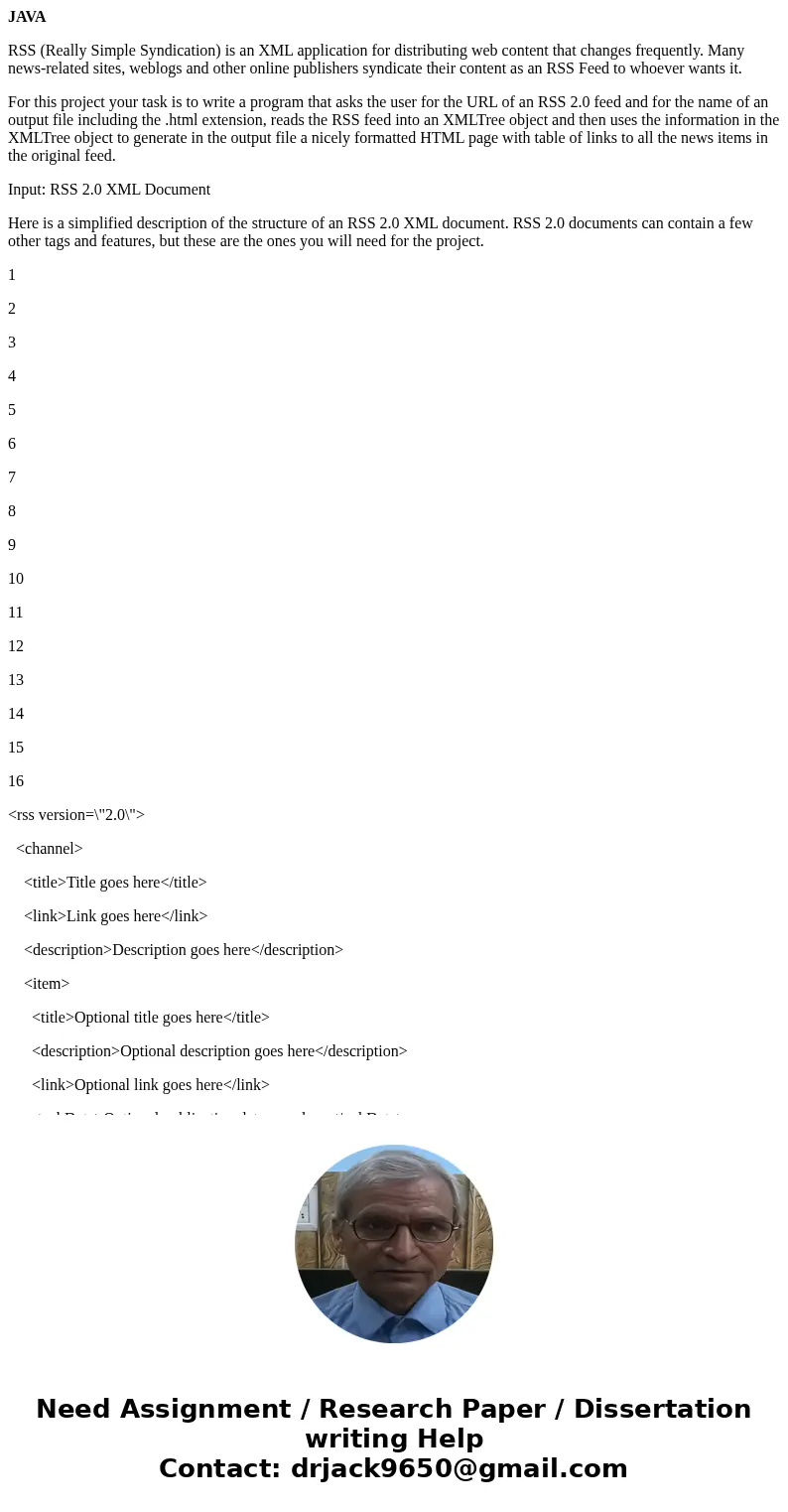
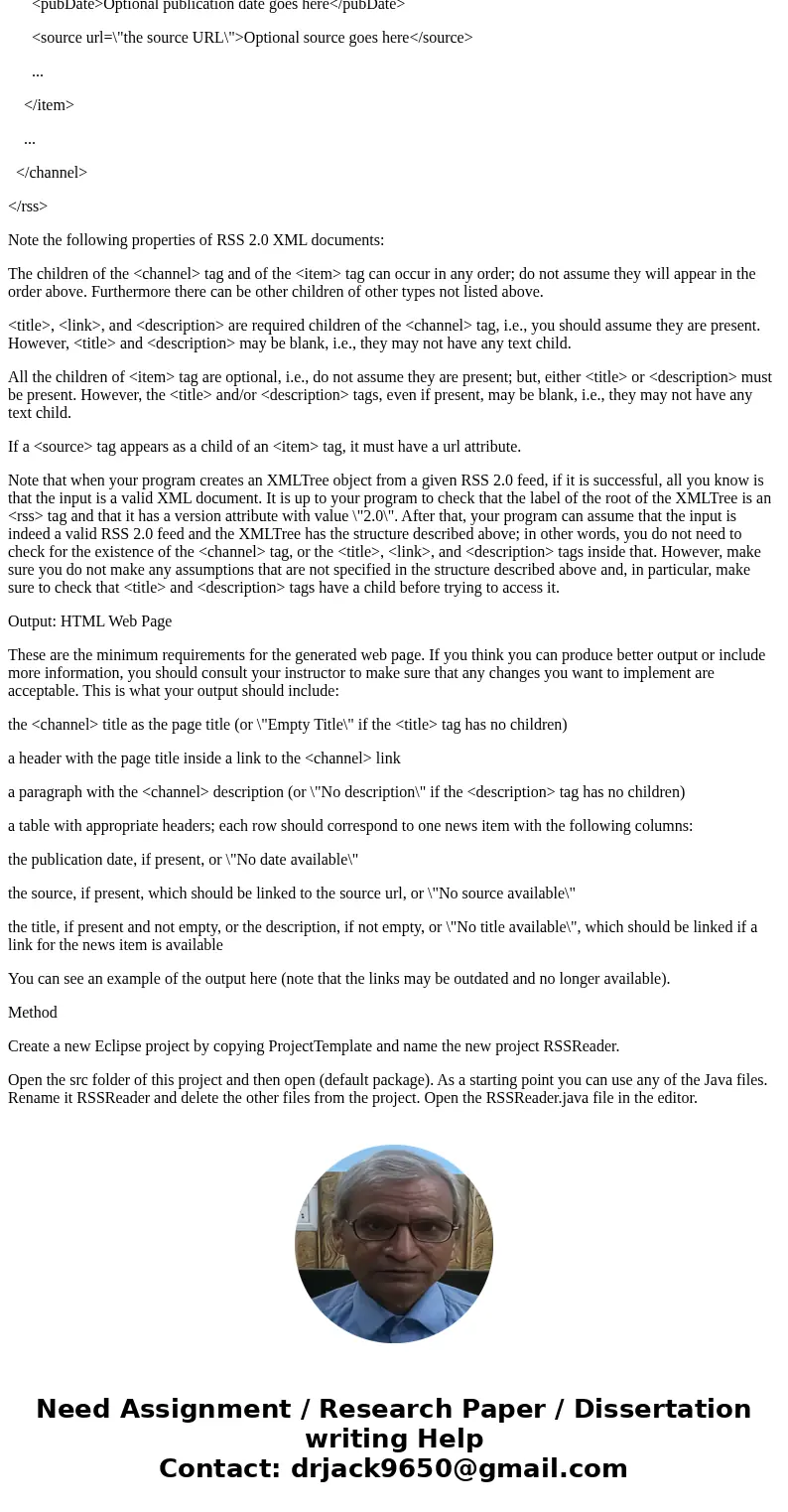
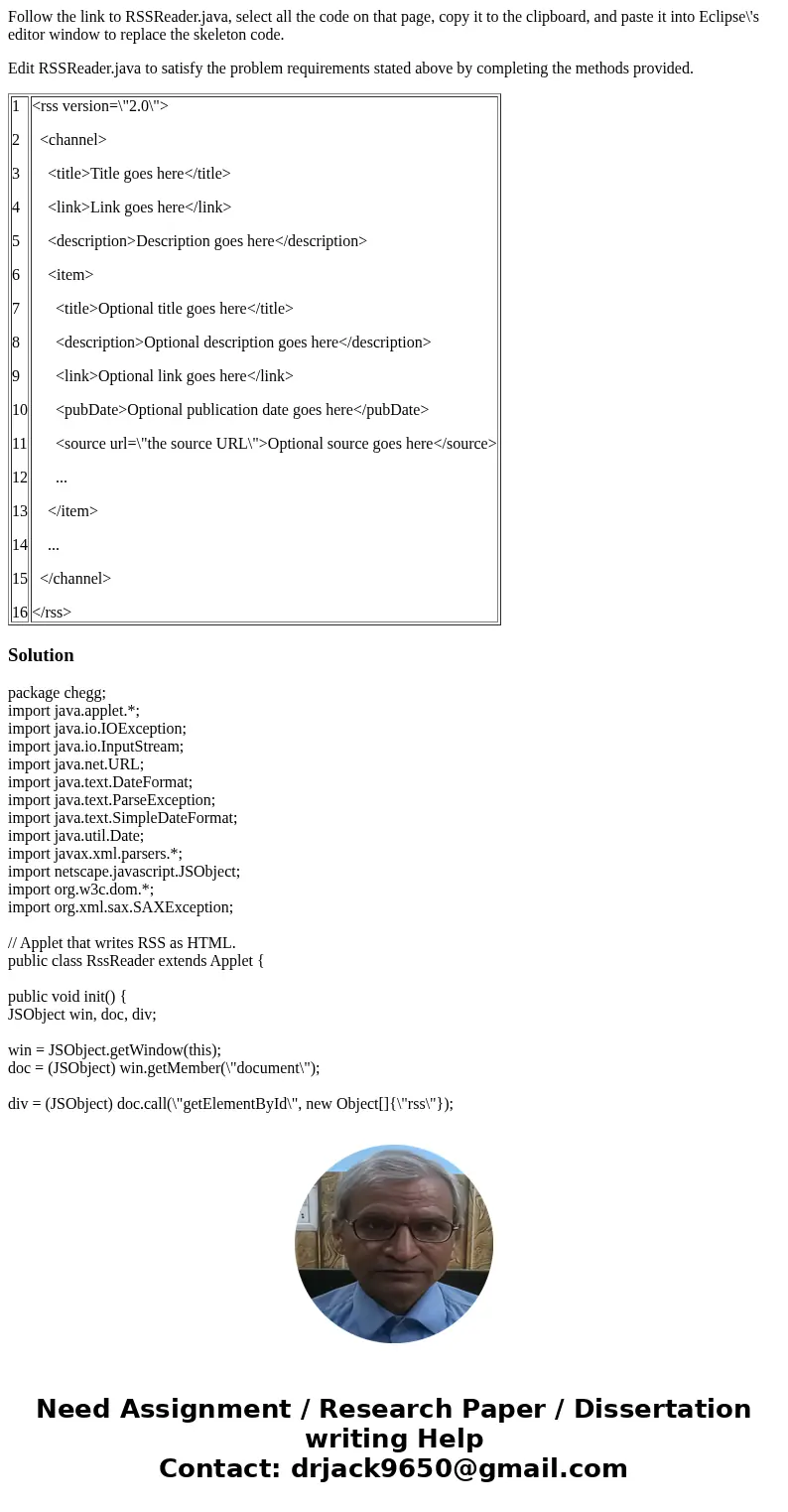
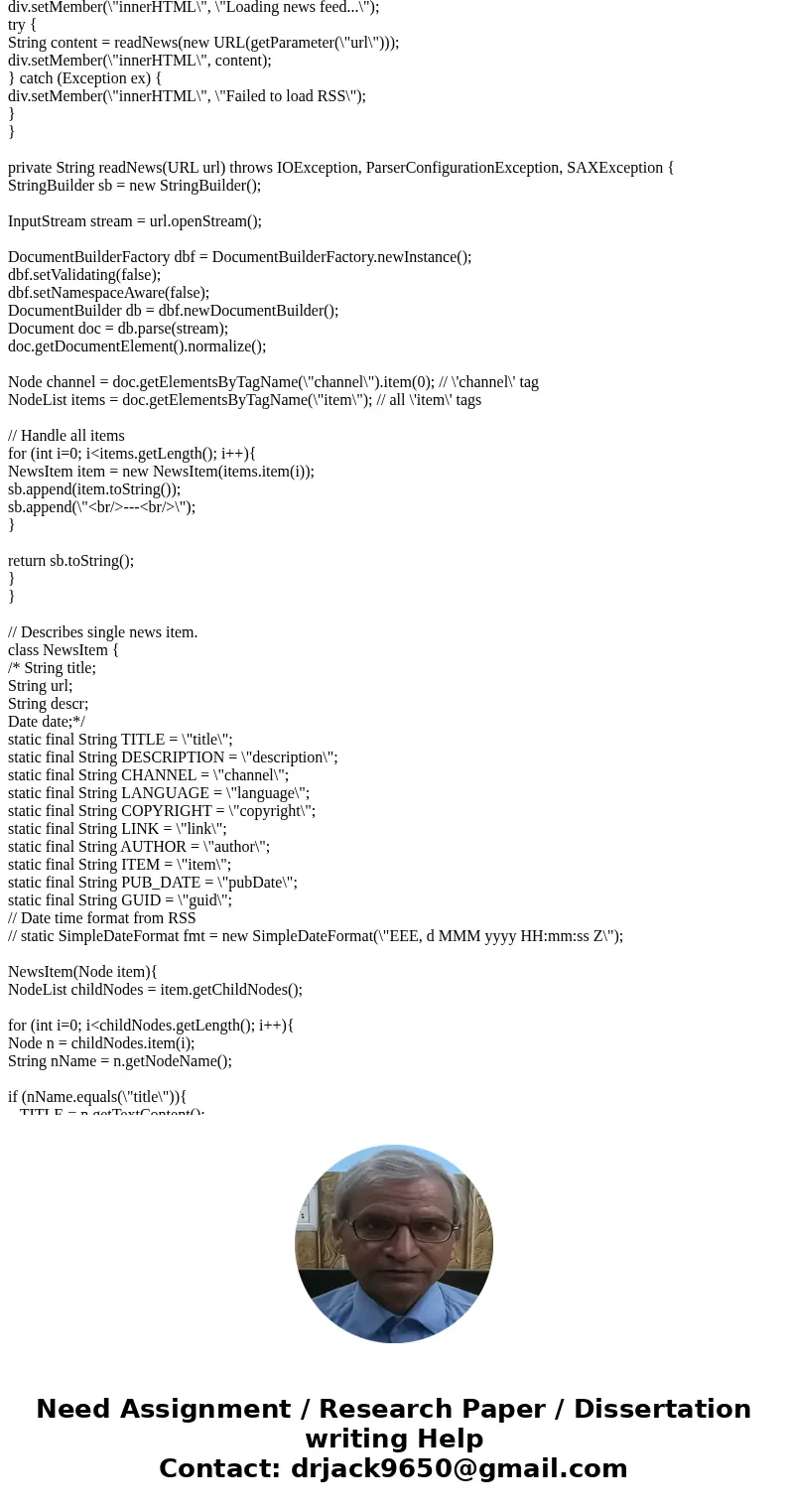
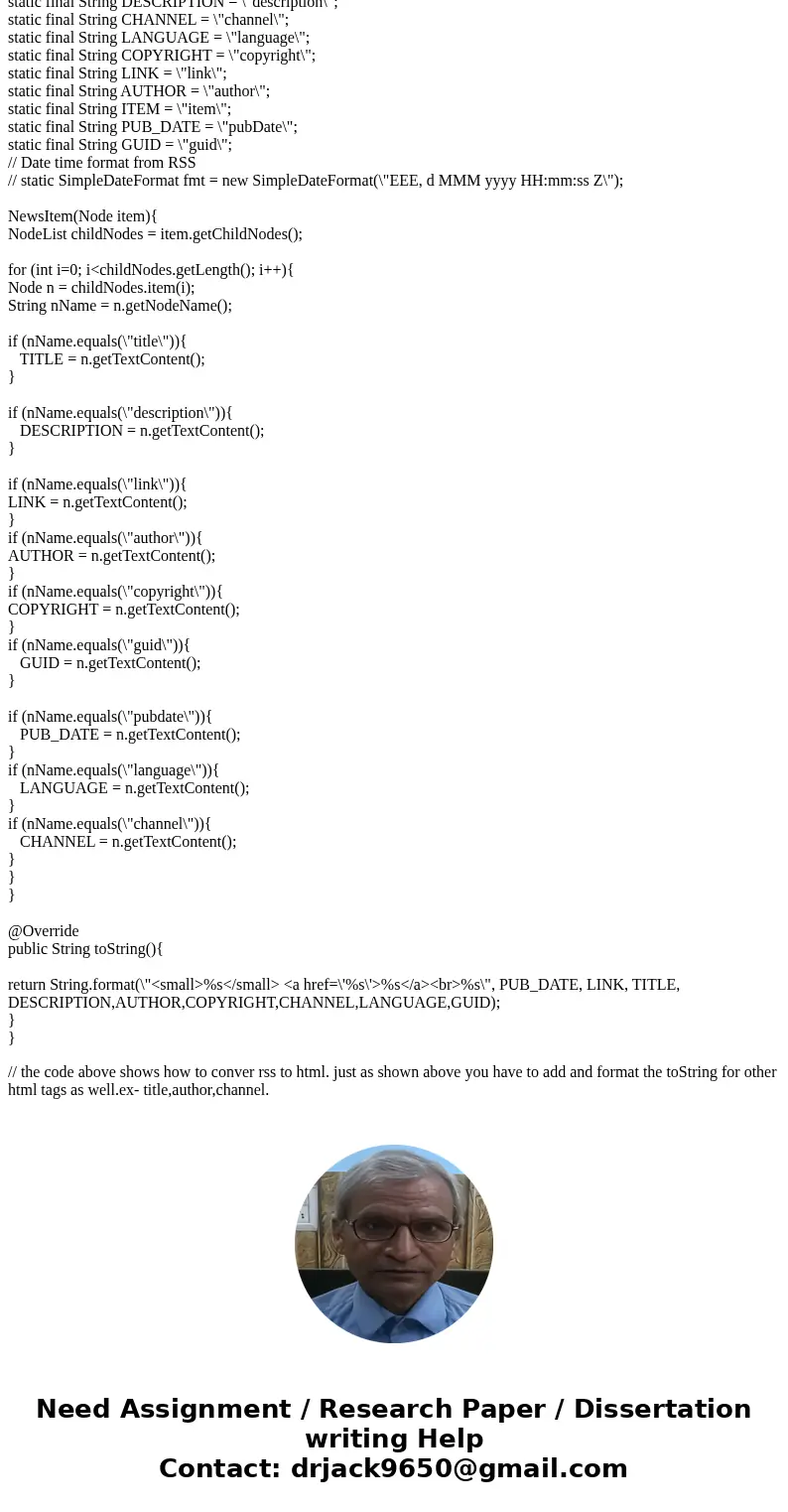
 Homework Sourse
Homework Sourse